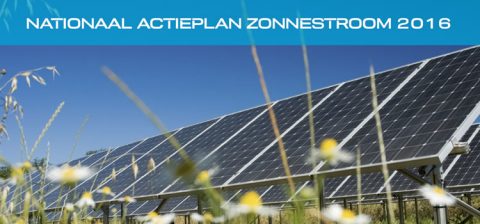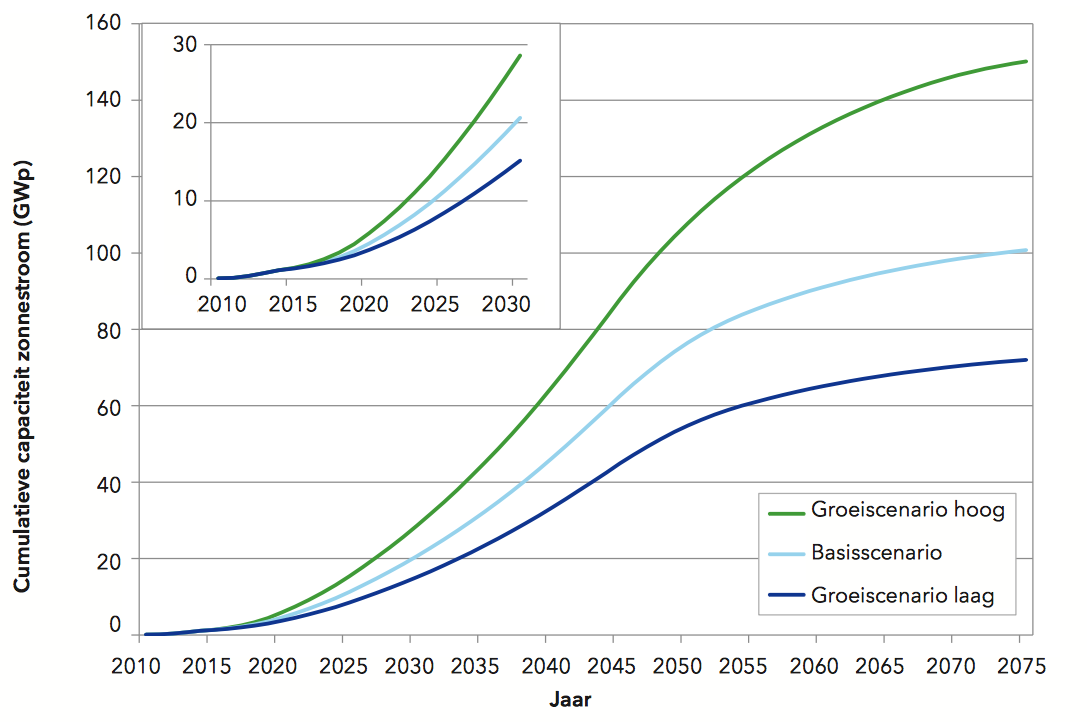
Zonnestroom kan in Nederland nog veel sterker groeien: naar 10 gigawatt
19 november 2015 – Over acht jaar kan in 7% van de Nederlandse stroombehoefte worden voorzien door zonnestroom. Met 10 gigawattpiek is zonnestroom dan goed voor 15% van de hernieuwbare elektriciteit.
Deze cijfers zijn de ambitie van het Nationaal Actieplan Zonnestroom (NAZ), een samenwerkingsverband van o.a. DNV GL, Holland Solar, Netbeheer Nederland, Rijksuniversiteit Utrecht, Mastervolt, TKI Zonne-energie en de stichting Monitoring Zonnestroom. Het NAZ wil de ontwikkeling van zonnestroom in Nederland bevorderen.
Uit een bericht van Solar Magazine
‘(…) Het NAZ hanteert in het geüpdatet actieplan een hoog en laag groeiscenario en baseert zich hierbij op een studie van het Planbureau voor de Leefomgeving (PBL) en DNV GL naar het potentieel voor de opwekking van zonnestroom op de daken van woningen en utiliteitsgebouwen in Nederland. Volgens deze studie blijkt het huidige dakpotentieel ongeveer 70 gigawattpiek te zijn op basis van de huidige technologie (‘Groeiscenario Laag’). Indien technologieverbeteringen en het potentieel buiten de bebouwde kom wordt meegenomen stijgt dit potentieel voor zonnestroom naar 150 gigawattpiek (‘Groeiscenario Hoog’).
Om de doelen te bereiken pleit het Nationaal Actieplan Zonnestroom (NAZ) voor ‘een passende regeling voor bezitters van zonnestroomsystemen, dit om hen zekerheid te bieden en innovaties te stimuleren voor eigen gebruik van opgewekte elektriciteit’. Door het succes van zonnestroom in de afgelopen jaren, was volgens het NAZ actualisering noodzakelijk. Belangrijke drijvende kracht achter de versnelde groei is de salderingsregeling, die in ieder geval tot 2020 wordt gegarandeerd.
In het NAZ zijn 20 acties geformuleerd. Een van de acties waar momenteel aangewerkt wordt, is de toekomst van salderen. Het actieplan hierover: ‘Consumenten weten dat de overheid salderen maar tot 2020 garandeert. Dit brengt onzekerheid en bedrijven merken dit nu al in de markt. Actiepunt: de overheid komt in samenspraak met de zonnestroomsector tot een geschikte overgangsregeling die zekerheid biedt voor bestaande en nieuwe bezitters van zonne-stroomsystemen. Gewenst resultaat: Door het wegnemen van de onzekerheid over salderen zal de groei van zonnestroom bij particulieren niet stagneren.’ (…)’

Uit het persbericht van DNV-GL
‘(…) Due to the success of solar power in recent years, the growth scenario for solar power is developing towards an accelerated scenario of no less than 10 GWp in 2023. Consequently, solar power supports the Energy Agreement and will supply 15% of renewable electricity by 2023. This is equivalent to 7% of the total electricity demand in the Netherlands. The major driving force behind this growth is the net metering scheme, which is currently guaranteed until 2020. Together with the expected flexible energy prices in the coming years, also for low-volume electricity consumers, innovations can be encouraged to help consumers use their own generated electricity as much as possible, for example through storage systems. This will make it possible to prevent overloading of the electricity grid and avoid unnecessary investments associated with grid reinforcements.
NAZ calls upon the government to join forces with the solar power sector to reach an appropriate arrangement that not only provides security for owners of solar power systems, but also provides sufficient room for innovations to encourage consumers to use their own generated electricity. The recently established Dutch Society for Sustainable Energy (NVDE) can provide a good platform for discussions between the parties involved in this field.
Growth scenarios
The success of solar power in recent years prompted NAZ to look further than the horizon and to outline growth scenarios beyond 2020. NAZ applies a high and a low growth scenario and bases itself on a study of the Netherlands Environmental Assessment Agency (PBL) and DNV GL into the potential for the generation of solar power on the roofs of homes and non-residential buildings in the Netherlands. According to this study, the current roof potential is approximately 70 GWp based on the current technology (‘Growth scenario Low’). When technology improvements and the potential outside urban areas are included, the potential for solar power increases to 150 GWp (‘Growth scenario High’). In the coming years, solar power will contribute significantly to the electricity supply in the Netherlands, making a high growth rate of 10 GWp in 2023 attainable.
National Action Plan on Solar Power
Since 2011, the National Action Plan on Solar Power has been committed to identifying and eliminating the societal barriers of solar energy. The National Action Plan on Solar Power 2016 can be downloaded here. In total, 20 actions were formulated with the intention, among other things, to provide consumers with good, objective and complete information, guarantee the quality of solar energy systems, develop local solar energy projects and stabilise the development of the solar energy market. NAZ is a partnership, led by DNV GL, with Holland Solar, Mastervolt, Netbeheer Nederland, Stichting Monitoring Zonnestroom, Sun Projects, TKI Solar Energy and Utrecht University. (…)’
Bronnen
Solar Magazine, 18 november 2015: Nationaal Actieplan Zonnestroom stelt target bij tot 10 gigawatt zon-pv in 2023
DNV-GL, persbericht, 18 november 2015: National Action Plan on Solar Power: Solar power will provide 2.5 million Dutch households with their entire electricity needs by 2023
Nationaal Actieplan Zonnestroom 2016 (pdf, 10 pag.)



